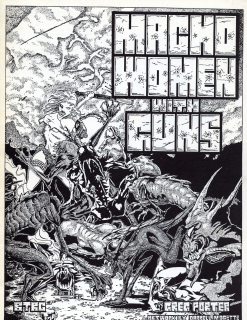billd91
Not your screen monkey (he/him) 🇺🇦🇵🇸🏳️⚧️
Indeed it is.And that's indeed a real game? Unlike the apocryphal Kung-Fu CB Mamas on Wheels vs. the Aztec Motorcycle Wrestling Nuns?

Indeed it is.And that's indeed a real game? Unlike the apocryphal Kung-Fu CB Mamas on Wheels vs. the Aztec Motorcycle Wrestling Nuns?

In accordance with the prophecyAs all threads do.
I knew I had heard that name before! Thank you for that blast from the pastFor the benefit of any passers-by unfamiliar with this hoary joke, Spawn of Fashan was famously (thanks to a review by Lawrence Schick in Dragon #60) unplayable, and immortalized in the TTRPGer classification quiz circa 1983.
Ah, I knew I was aging myself with that reference.I have no idea how to compare it to SoF; I just mentioned it because I think it has the funniest name of any RPG.
(And TSL is actually playable, and a lot of fun!)
It is best to write adventures for systems you know nothing about. lol
Next up: reviews for books we have never read.
Reviews for books that were never written would be easier...

I mean, I used to play Synnibarr and I know that was at playable, at least with Raven running it, but this 2017 review of Fashan seems to point out a lot of issues.I've read it and, while it's certainly not my kind of game, it didn't look that bad. Then Lawrence Schick did a review that went viral before the Web.
The first thing that struck me about the character creation process was that, though there are (apparently) no player-character races in the world of Fashan other than humans, males and females were created differently. With males, all statistics are generated "normally." With females, the number of dice rolled for strength, constitution, and hit points were halved, the number of dice rolled for charisma was multiplied by 1.5, and all females had "Intuition." (But don't worry, the creators of the game aren't sexist -- after all, they emphasize that they are not sexist in Section I. Imagine me rolling my eyes here.) Realizing this would make the character creation process more interesting, I decided to make my character female.
I then had to look up what "Intuition" was. A note next to the term, in square brackets, said "[see the 'Destiny' listing on the Mental Illness table]." (Great, so intuition is a mental illness, and all females have it? But I forged ahead.) Finding the Mental Illness table was the first obstacle, and it led me into the wonderful world of all the jumbled, haphazardly organized charts of Section VII. If the Mental Illness table had been, say "Table 21. Mental Illnesses", I could have at least jumped right to the 21st table, but nooooooo. Instead, the Mental Illness table was buried in a sub-division called "The Body Roll Charts," which were sequestered in Division C of Section VII, which was a Division that only the Referee was supposed to see. (Not that any Referee would have caught a player peeking at Division C, since the place where Division B ended and Division C actually began was hidden away on the one-and-only page of the text that was printed sideways.) At the end of the Mental Illness table was indeed an entry called "Destined", which instructed the Referee to roll on the Destiny Table for the character. A very helpful note below this entry informed me that "Due to the necessity of having the Destiny Table interlock with the Referee's cultures and history, it is not given here."
In fact, there was no "Destiny Table" anywhere in the text. Apparently, The Spawn of Fashan was designed to be "open-ended" so that the Referee could put any cultural-specific stuff he wanted to into the game without having to violate the game's rules. Which means that a sizable percentage of the things that have to be defined for a character don't appear in the core rules. Division D of Section VII does give us one little "sample" game setting, but it too lacks a Destiny Table. (The sample game setting, by the way, was called "Boosboodle, a land just south of where Melvin is standing now." I swear I am not making this up.)
I flipped back to Section V, on the Art of Combat, in Division B, "Preparation for Combat," which is where it described how to calculate Armor Class. It said to combine the AMC Drop of the armor with the AMC Drop listed on her Reflexes Table (flip back to Statistics Charts, look up Reflexes Table, a Creeper uses table A of the Reflexes Table, so I look up Grignr's Reflexes of 19 and find that she has a -1 AMC modifier, which for some reason was not one of the functions I had to calculate during step five of the character creation process). So, my total AMC Drop is 5 for the armor, and 1 for her Reflexes, for a total of 6, right? Wrong. Each of four areas of your body -- area 1, the head and neck; area 2, the torso; area 3A, the arms; and area 3L, the legs -- has its own separate AMC drop, depending upon whether any armor covers that area or not. The coverage of a piece of armor is listed on the Armor Class Chart. According to that chart, a cloak only protects the arms, legs, and back, so her AMC drop in area 1 is 1, in areas 3A and 3L is 6, and in area 2 is apparently 1 if attacking from the front (or the sides?) and 6 if attacking from the rear.
However, it's not enough to know her AMC drop. The blank spots on her character sheet call for the actual AMC of each area. How is one supposed to calculate this? The definition of "Armor Class" says that AMC begins with 11 and goes down, but later says that an unarmored human's AMC (not counting his reflexes) is ten. Section VI, Division G, on the philosophy of creating animals and monsters, also says that the AMC of a naked human is 10. Drawing upon my decades of AD&D experience, I leapt to the brilliant conclusion that you were supposed to subtract your AMC drop from 10 to compute your AMC. And this I did. Grignr's Area 1 AMC was 9, her area 2 AMC was 9 (4 in back), and her areas 3A and 3L AMC were 4 each.
Stanislaw Lem wrote a whole book of those, called A Perfect Vacuum! It's awesome! He followed it up with a book of introductions to nonexistent books, which i didn't like as much, Imaginary Magnitude.Reviews for books that were never written would be easier...
I mean, they dug their own grave by choosing to play a female human in a game published in the 80s. Not that it was that much more playable to make a male, as the review points out...I mean, I used to play Synnibarr and I know that was at playable, at least with Raven running it, but this 2017 review of Fashan seems to point out a lot of issues.
